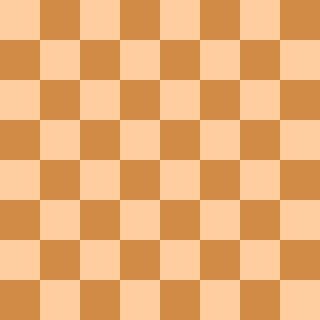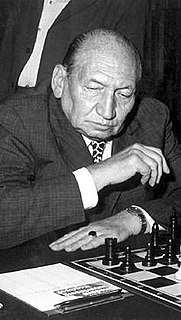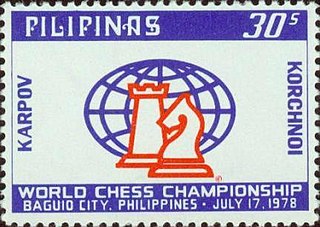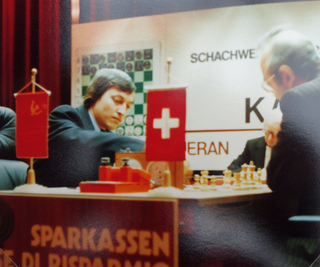
Losing Chess is one of the most popular chess variants. The objective of each player is to lose all of their pieces or be stalemated, that is, a misère version. In some variations, a player may also win by checkmating or by being checkmated.

The Evergreen Game is a famous chess game, won by Adolf Anderssen against Jean Dufresne in 1852.
X3D Fritz was a version of the Fritz chess program, which in November 2003 played a four-game Human–computer chess match against world number one Grandmaster Garry Kasparov. The match was tied 2–2, with X3D Fritz winning game 2, Kasparov winning game 3 and drawing games 1 and 4.

The Scotch Game, or Scotch Opening, is a chess opening that begins with the moves:

The Halloween Gambit is an aggressive chess opening gambit in which White sacrifices a knight early on for a single pawn. The opening is an offshoot of the normally staid Four Knights Game and is defined by the moves:
Rosendo Carreon Balinas, Jr. was a chess grandmaster from the Philippines. FIDE awarded him the International Master title in 1975 and the International Grandmaster title in 1976. Balinas was a lawyer by profession, as well as a chess writer and journalist.

Erich Gottlieb Eliskases was a chess grandmaster of the 1930s and 1940s, who represented Austria, Germany and Argentina in international competition. He had many successes and in the late 1930s was considered a potential contender for the World Championship.
In chess, a desperado piece is a piece that is en prise or trapped, but captures an enemy piece before it is itself captured. This can be in either a situation where both sides have hanging pieces, "...in which you use your doomed piece to eat as much material as possible before it dies"; or alternatively a sacrifice that will result in stalemate if it is captured.

The World Chess Championship 2006 was a match between Classical World Chess Champion Vladimir Kramnik, and FIDE World Chess Champion Veselin Topalov. The title of World Chess Champion had been split for 13 years. This match, played between September 23 and October 13, 2006, in Elista, Kalmykia, Russia, was to reunite the two World Chess Champion titles and produce an undisputed World Champion.
Leopold Adamovich Mitrofanov was a Russian chess composer, an International Judge of Chess Composition and an International Master of Chess Composition. He was born in Leningrad and, by profession, was a chemical engineer.

In chess, a swindle is a ruse by which a player in a losing position tricks his opponent, and thereby achieves a win or draw instead of the expected loss. It may also refer more generally to obtaining a win or draw from a clearly losing position. I. A. Horowitz and Fred Reinfeld distinguish among "traps", "pitfalls", and "swindles". In their terminology, a "trap" refers to a situation where a player goes wrong through his own efforts. In a "pitfall", the beneficiary of the pitfall plays an active role, creating a situation where a plausible move by the opponent will turn out badly. A "swindle" is a pitfall adopted by a player who has a clearly lost game. Horowitz and Reinfeld observe that swindles, "though ignored in virtually all chess books", "play an enormously important role in over-the-board chess, and decide the fate of countless games".

The Balogh Defense is an unusual chess opening beginning with the moves:
The World Chess Championship 1889 was the second official World Chess Championship, and was between Wilhelm Steinitz and Mikhail Chigorin. It took place in Havana, Cuba. Steinitz successfully defended his world title, by being the first of the two players to reach 10½. He won the match 10½-6½.
The third World Chess Championship was held in New York City in late 1890 and early 1891. Holder William Steinitz narrowly defeated challenger Isidor Gunsberg.

The 1978 World Chess Championship was played between Anatoly Karpov and Viktor Korchnoi in Baguio City, Philippines from July 18 to October 18, 1978. Karpov won, thereby retaining the title.

The 1981 World Chess Championship was played between Anatoly Karpov and Viktor Korchnoi in Merano, Italy from October 1 to November 19, 1981. Karpov won.

The Nadanian Variation of the Grünfeld Defence is a chess opening characterised by the moves:
In chess, checkmates in the opening are examples of a player being checkmated during the first few moves of the game. Some common or notable mating patterns have names of their own. These include Fool's mate, Scholar's mate, and Légal's mate.

The Semi-Italian Opening is one of Black's responses to the Italian Game. It begins with the moves:














